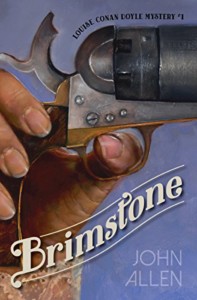 Title: Brimstone – Louise Conan Doyle Mystery #1
Title: Brimstone – Louise Conan Doyle Mystery #1
Author: John Allen
Publisher: Allen & Allen Semiotics, Inc.
ISBN: 978-0-9842716-9-6
Pages: 224
Genre: Mystery
Reviewed by: Carol Davala
Pacific Book Review Star
Awarded to Books of Excellent Merit

From the traditional acceptance of Sir Arthur Conan Doyle as the original creator of the renowned Sherlock Holmes, to the recent popularity of the modern day TV drama “Elementary” featuring a contemporary update on the classic British sleuth, these intricate crime-solving collections have clearly withstood the test of time. Here in Brimstone – Louise Conan Doyle Mystery #1 the first release in the Louise Conan Doyle 12-book mystery series, author John Allen takes the original premise in an exciting new direction. This clever new reveal artfully introduces a fictional version of the fascinating woman Allen believes to be the actual inventor of the Sherlock Holmes character, Doyle’s first wife, Louise Hawkins Conan Doyle. Showcasing the scholarly investigator prior to her creation of the legendary detective, Allen places her in the enigmatic limelight in the hopes she will receive her due credit.
When Louise Hawkins discovers a distraught and pregnant Anna Perenna standing near the body of her dead husband, a Lieutenant recently returned from a lengthy stint in Afghanistan – there is a gun on the floor and the sharp smell of brimstone in the air. Hawkins soon finds herself caught up in an investigation and a trial that may send the soon to be mother to the gallows. With the primary help of her savant, epileptic brother, and an objective newspaper publisher harboring a well-guarded secret of his own, Hawkins makes an all-out effort to prove Anna’s innocence. In this entertaining blend of story, fact and surmising, readers meet a strong-willed, inquisitive intellectual looking to uncover the truth. Facing contrary opinion and increasing obstacles, this feisty female faces the challenges of a Victorian era and its patriarchal edicts head on. This is a captivating consideration for the archives of great mystery writing.
Set in England in 1879, the story plays out over a month’s span. Though there are a few segues to earlier years referencing the central character’s formative childhood, primarily the action moves ahead in a well-paced chronological timeline. Chapter headings noting time, date, and place are a handy reference. From boarding houses and dead rooms, to pawn shops and courtrooms, Allen allows the drama to unfold against colorful, well-detailed backdrops. It is an intricately crafted landscape marked by cobblestone streets, the plague of TB, a cat’s eyes used to judge time for photo exposures, and shrieking tea kettles piercing the air of gruesome crime scenes. Here nuances of the 19th century are rendered amidst the slight formality of language and particular vocabulary.
Through the strong, indomitable spirit of Hawkins, Allen taps into a persevering feminist theme. Whether determined to scale a wall in her cumbersome frocks, or withstanding imprisonment to justify her beliefs in a male dominated society, here the disadvantages of womanhood are likened to the disabilities of an epileptic. From Hawkins’ love of Louisa May Alcott’s sensational alter ego writings as the androgynous A.M. Barnard, to a judge’s admonishment ” … I will have no person, much less a woman so flagrantly challenge the authority of this court …” this character is represented as an unrelenting force with modern day appeal. Additional contemporary comparisons are also made by way of reporters and photographers (paparazzi of the day) who storm the crime scenes, numerous newspaper headlines convicting the alleged criminal before the trial, and particular mention in the book’s closing of a present day incarceration where Allen identifies similarities to the case featured in Brimstone.
Allen has created a provocative mystery laced with secrets, scandal, and even bits of humor. With memorable characters and an eye for detail (including a well-placed nod to a familiar magnifying glass), this series debut showcasing a viable alternative to the original Doyle/Sherlock Holmes contention, should appeal to any classic mystery lover, and especially those who can appreciate a smart and savvy woman, ahead of her time.

